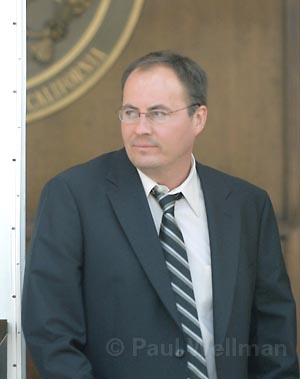Bias, Legality Once Again Debated at News-Press Hearing
Editorial Page Editor Travis Armstrong Continues Testimony

After a week-long break in the trial of the Santa Barbara News-Press on charges of interfering with union organizing, editorial page editor Travis Armstrong resumed the stand in an effort to poke holes in the government’s case against the paper.
Among other things, Ampersand Publishing’s attorneys continued trying to prove that reporter Anna Davison was indeed fired-as the News-Press claims-for biased news reporting and not-as the lawyers for the National Labor Relations Board allege-for her union activism. To that end, Barry Cappello, Ampersand’s lead attorney, elicited Armstrong’s testimony that News-Press publisher Wendy McCaw, in her weekly meetings with him, complained “more times than I can count” about the slant in articles written about the Channel Islands National Marine Sanctuary restoration program both by Davison and fellow fired reporter Melina Burns. McCaw deplored the restoration plan because it involved killing all of the pigs on Santa Cruz Island, and according to Armstrong, she felt that the two reporters seemed to take the side of the government and Nature Conservancy, which owns the island. Ampersand attorneys also zeroed in again on the question again of whether Davison, in writing an article on the State Street Beautification Project, gave short shrift to the downside of removing street trees as part of the refurbishment, though she mentioned the opposition of longtime community members. Cappello insisted that when Davison was unable to locate sources to quote lamenting the tree removal, she should have interviewed Armstrong, McCaw or News-Press co-publisher Arthur Von Weisenberger, or at least quoted the trio’s editorials against the trees’ removal. “Is it a practice in the industry for reporters to balance a story if they need to by citing the editorial opinion of that paper?” Cappello asked. To which Armstrong responded, “If they need to, yes.”
The Ampersand team offered no examples of reporters quoting their own publishers’ opinions to balance a story that was not about the publisher. The closest they came to relevant examples was Armstrong’s tentative recollection that a News-Press reporter may have cited an opinion column by Armstrong, in which he exposed the illegal use of County Fire Department property to distribute Janet Wolf campaign signs. Armstrong also speculated that a News-Press reporter might have quoted him when he moderated a candidates’ forum.
To counter claims that union organizers were given poor marks on their 2006 performance reviews-and were thereby denied bonuses-in retaliation for protected union activity, Ampersand attorneys called Human Resources Director Yolanda Apodaca to testify. She confirmed that that several employees received improved performance evaluations in 2006 despite the fact that they were union supporters, as proven by the fact that they had worn to work the black T-shirts indicating solidarity with the union organizing effort.
To defend the News-Press‘s firing of six employees on charges of disloyalty following a union demonstration in February, Ampersand also brought to the stand the Chief of Encroachment Permits for Caltrans, Paul Cavanaugh. The NLRB lawyers contend that the demonstration was protected union activity and that the News-Press had no right to fire them for it. However, according to Cavanaugh, the signs that the union activists held up on the Anapamu Street overpass on February 2, including the black-and-red banner reading “Cancel Your Newspaper Today!” were “unauthorized encroachments” on freeway right-of-way and amounted to misdemeanor offenses. Only official Caltrans signage is allowed along a freeway, he added, and the color red is reserved strictly for stop signs. NLRB attorney Steve Wyllie objected that the signs’ violation of Caltrans regulations was irrelevant, since the News-Press claimed that it fired the employees for disloyalty, not for breaking the law. (Wyllie’s team also introduced evidence that Armstrong had not lost his job despite an arrest for drunk driving.) However, the judge allowed Cavanaugh’s testimony under Cappello’s theory that if the activity was illegal, then it was not protected union activity. Wyllie reiterated that he disagreed with that theory.



